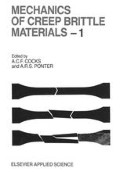Abstract
The results are reported of a study of the temperature and time response of yttria stabilised cubic zirconia, both in polycrystalline and single crystal form, to Knoop indentations in the ranges 290–1073 K and 10–10 000 s. The single crystal data lie consistently above the polycrystalline results. Indentation creep is observed at all temperatures with the rate of creep increasing at higher temperatures. The results are analysed and discussed in terms of the available models of indentation creep. A transition in deformation mechanism occurs at approximately 650 K for both materials. The activation energies and stress exponents were determined as 36 and 273 kJ/mol, and 40 and 20 for the single crystal, and 109 and 247 kJ/mol, and 53 and 29 for the polycrystalline below and above 600 K, respectively. At the higher temperatures, deformation is pipe diffusion dislocation climb controlled, whilst at the lower temperatures dislocation glide is the rate determining process.
Access this chapter
Tax calculation will be finalised at checkout
Purchases are for personal use only
Preview
Unable to display preview. Download preview PDF.
References
Parr, N.L., Martin, G.F. and May, E.R.W., Preparation, microstructure and mechanical properties of silicon nitride. In Special Ceramics 1960. ed., P. Popper, Haywood, London, 1960, p. 120.
Edington, J.W., Rowcliffe, D.J. and Henshall, J.L., Powder Metallurgical Review 8: The mechanical properties of silicon nitride and silicon carbide. Powder Met. Int., 1975, 2, 82–96 & 136–147.
Garvie, R.C., Hannink, R.H and Pascoe, R.T., Ceramic steel?, Nature, 1975, 258, 703–704.
Claussen, N. Strengthening strategies for Zr02 ceramics at high temperatures. Mat. Sci. Eng., 1985, 71, 23–39.
Tabor, D., Indentation Hardness and its measurement: some cautionary comments. In Microindentation Techniques in Materials Science and Engineering, ASTM STP 889, eds., P.J. Blau and B.R. Lawn, American Society for Testing and Materials, Philadelphia, 1986, pp. 129–159.
Bishop, R.F., Hill, R. and Mott, N.F., The theory of indentation hardness tests. Proceedings of the Physical Society (U.K.), 1945, 57, 147–159.
Marsh, D.M., Plastic Flow in Glass. Proc. Roy. Soc. (London), 1964, A279, 420–435.
Johnson, K.L., The correlation of indentation experiments. J. Mech. Phys. Sol., 1970, 18, 115–126.
Chiang, S.S., Marshall, D.B. and Evans, A.G., The response of solids to elastic plastic indentation. I. stresses and residual stresses. Journal of Applied Physics, 1982, 53, 298–311.
Mulhearn, T.O. and Tabor, D., Creep and Hardness of metals: A physical study. J. Inst. Met., 1960–61, 89, 7–12.
Atkins, A.G., Silverio, A. and Tabor, D., Indentation hardness and the creep of solids. J. Inst. Met., 1966, 94, 369–378.
Morgan, J.E., Indentation hardness and indentation creep in solids at temperatures below 0.5 T m. Ph.D. Dissertation, University of Exeter, Exeter, U.K., 1976.
Sherby, O.D. and Armstrong, P.E., Prediction of activation energies for creep and self diffusion from hot hardness data. Metall. Trans., 1971, 2, 3479–3484.
Roebuck, B. and Almond, E.A., Equivalence of indentation and compressive creep tests on a WC/Co hardmetal. J. Mat. Sci. Letters, 1982, 1, 519–522.
Chu, S.N.G. and Li, J.C.M., Impression creep: A new creep test. J. Mat. Sci., 1977, 12, 2200–2208.
Ingel, R.P., Structure-mechanical property relationships for single crystal yttrium oxide stabilised zirconium oxide. Ph.D. Dissertation, Catholic University of America, Washington, D.C., 1982; University Microfilms International (Ann Arbor, MI) Order No. 83–02474.
Sato, T., Ohtaki, S. and Endo, T., Transformation of yttria doped tetragonal doped polycrystals by annealing under controlled humidity conditions. J. Amer. Ceram. Soc., 1985, 68, C320-C322.
Kandil, H.M., Greiner, J.D. and Smith J.F., Single-crystal elastic constants of yttria-stabilised zirconia in the range 20° to 700°C. J. Amer. Ceram. Soc., 1984, 67, 341–346.
Evans, P.S.E., creep in yttria- and scandia-stabilised zirconia. J. Amer. Ceram. Soc., 1970, 53, 365–369.
Seltzer, M.S. and Talty, P.K., High-temperature creep of Y2O3 -stabilised ZrO2. J. Amer. Ceram. Soc., 1975, 58, 124–130.
Rutman, D.S., Maurin, A.F., Toropov, Yu.S., Pliner, S.M., Taksis, G.A., Dauknis, V.I., Kazakyavichus, K.A., Peras, A.Ya., Martinaiten, V.I. and Yakushka, V.I., Study of the creep of constructional zirconia ceramics at high temperatures. Refractories (U.S.A.), 1980, 21, 212–215.
Wakai, F., Sakaguchi, S. and Matsuno, Y., Superplasticity of yttria-stabilised tetragonal Zr02 polycrystals. Advanced Ceramic Materials, 1986, 1, 259–263.
Dimos, D. and Kohlstedt, D.L., Diffusional creep and kinetic demixing in yttria-stabilised zirconia. J. Amer. Ceram. Soc., 1987, 70, 531–536.
Fehrenbacher, L.L., Bailey, F.P. and McKinnon, N.A., Compressive creep of yttria rare earth stabilised zirconia storage heater refractories. SAMPE Quarterly, 1971, 2, 48–60.
Guillou, M., Carter, G.C., Henshall, J.L. and Hooper, R.M., Anisotropy of hardness and fracture in single crystal calcia and yttria stabilised cubic zirconia. in preparation.
Dominguez-Rodriguez, A., Lagerhof, K.P.D. and Heuer, A.H., plastic deformation and solid-solution strengthening of yttria stabilised zirconia. J. Amer. Ceram. Soc., 1986, 69, 281–284.
Subbarao, E.C. and Maiti, H.S., Oxide electrolytes with fluorite structure. In Progress in Solid Electrolytes, eds. T.A. Wheat, A. Ahmad and A.K. Kuriakose, Energy, Mines and Resources, Ottawa, Canada, 1983, pp. 281–312.
Oishi, Y., Ando, K. and Sakka, Y., Lattice and grain-boundary diffusion coefficients of cations in stabilised zirconias. In Advances in Ceramics Vol. 7, eds., M.F. Yan and A.H. Heuer, American Ceramics Society, Columbus, OH, 1983, pp. 208–219.
Frost, H.J. and Ashby, M.F., Deformation-Mechanism Maps The Plasticity and Creep of Metals and Ceramics, Pergamon Press, Oxford, 1982, pp. 93–97.
Author information
Authors and Affiliations
Editor information
Editors and Affiliations
Rights and permissions
Copyright information
© 1989 Elsevier Science Publishers Ltd
About this chapter
Cite this chapter
Henshall, J.L., Carter, G.M., Hooper, R.M. (1989). Indentation Creep in Zirconia Ceramics Between 290 K and 1073 K. In: Cocks, A.C.F., Ponter, A.R.S. (eds) Mechanics of Creep Brittle Materials 1. Springer, Dordrecht. https://doi.org/10.1007/978-94-009-1117-8_9
Download citation
DOI: https://doi.org/10.1007/978-94-009-1117-8_9
Publisher Name: Springer, Dordrecht
Print ISBN: 978-94-010-6994-6
Online ISBN: 978-94-009-1117-8
eBook Packages: Springer Book Archive

